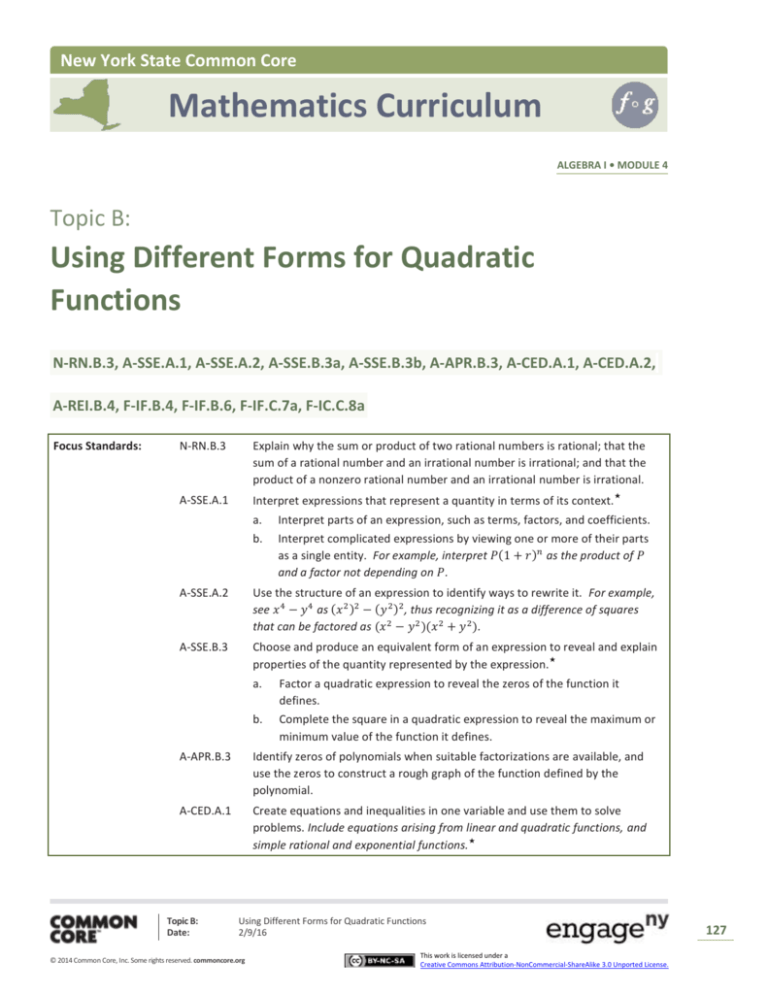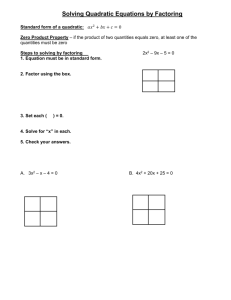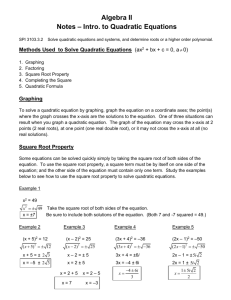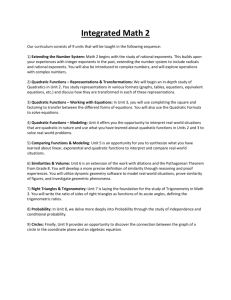
New York State Common Core
Mathematics Curriculum
ALGEBRA I • MODULE 4
Topic B:
Using Different Forms for Quadratic
Functions
N-RN.B.3, A-SSE.A.1, A-SSE.A.2, A-SSE.B.3a, A-SSE.B.3b, A-APR.B.3, A-CED.A.1, A-CED.A.2,
A-REI.B.4, F-IF.B.4, F-IF.B.6, F-IF.C.7a, F-IC.C.8a
Focus Standards:
N-RN.B.3
Explain why the sum or product of two rational numbers is rational; that the
sum of a rational number and an irrational number is irrational; and that the
product of a nonzero rational number and an irrational number is irrational.
A-SSE.A.1
Interpret expressions that represent a quantity in terms of its context.
★
a.
Interpret parts of an expression, such as terms, factors, and coefficients.
b.
Interpret complicated expressions by viewing one or more of their parts
as a single entity. For example, interpret 𝑃(1 + 𝑟)𝑛 as the product of 𝑃
and a factor not depending on 𝑃.
A-SSE.A.2
Use the structure of an expression to identify ways to rewrite it. For example,
see 𝑥 4 − 𝑦 4 as (𝑥 2 )2 − (𝑦 2 )2 , thus recognizing it as a difference of squares
that can be factored as (𝑥 2 − 𝑦 2 )(𝑥 2 + 𝑦 2 ).
A-SSE.B.3
Choose and produce an equivalent form of an expression to reveal and explain
★
properties of the quantity represented by the expression.
a.
Factor a quadratic expression to reveal the zeros of the function it
defines.
b.
Complete the square in a quadratic expression to reveal the maximum or
minimum value of the function it defines.
A-APR.B.3
Identify zeros of polynomials when suitable factorizations are available, and
use the zeros to construct a rough graph of the function defined by the
polynomial.
A-CED.A.1
Create equations and inequalities in one variable and use them to solve
problems. Include equations arising from linear and quadratic functions, and
★
simple rational and exponential functions.
Topic B:
Date:
Using Different Forms for Quadratic Functions
2/9/16
© 2014 Common Core, Inc. Some rights reserved. commoncore.org
This work is licensed under a
Creative Commons Attribution-NonCommercial-ShareAlike 3.0 Unported License.
127
Topic B
NYS COMMON CORE MATHEMATICS CURRICULUM
M4
ALGEBRA I
A-CED.A.2
Create equations in two or more variables to represent relationships between
★
quantities; graph equations on coordinate axes with labels and scales.
A-REI.B.4
Solve quadratic equations in one variable.
a.
Use the method of completing the square to transform any quadratic
equation in 𝑥 into an equation of the form (𝑥 − 𝑝)2 = 𝑞 that has the
same solutions. Derive the quadratic formula from this form.
b.
Solve quadratic equations by inspection (e.g., for 𝑥 2 = 49), taking square
roots, completing the square, the quadratic formula and factoring, as
appropriate to the initial form of the equation. Recognize when the
quadratic formula gives complex solutions and write them as 𝑎 ± 𝑏𝑖 for
real numbers 𝑎 and 𝑏.
F-IF.B.4
For a function that models a relationship between two quantities, interpret key
features of graphs and tables in terms of the quantities, and sketch graphs
showing key features given a verbal description of the relationship. Key
features include: intercepts; intervals where the function is increasing,
decreasing, positive, or negative; relative maximums and minimums;
★
symmetries; end behavior; and periodicity.
F-IF.B.6
Calculate and interpret the average rate of change of a function (presented
symbolically or as a table) over a specified interval. Estimate the rate of change
★
from a graph.
F-IF.C.7a
Graph functions expressed symbolically and show key features of the graph, by
★
hand in simple cases and using technology for more complicated cases.
a.
F-IF.C.8a
Write a function defined by an expression in different but equivalent forms to
reveal and explain different properties of the function.
a.
Instructional Days:
Graph linear and quadratic functions and show intercepts, maxima, and
minima.
Use the process of factoring and completing the square in a quadratic
function to show zeros, extreme values, and symmetry of the graph, and
interpret these in terms of a context.
7
Lessons 11–12: Completing the Square (E, P)1
Lesson 13: Solving Quadratic Equations by Completing the Square (P)
Lesson 14: Deriving the Quadratic Formula (P)
Lesson 15: Using the Quadratic Formula (P)
Lesson 16: Graphing Quadratic Equations From the Vertex Form, 𝑦 = 𝑎(𝑥 − ℎ)2 + 𝑘 (E)
Lesson 17: Graphing Quadratic Functions From the Standard Form, 𝑓(𝑥) = 𝑎𝑥 2 + 𝑏𝑥 + 𝑐 (P)
1
Lesson Structure Key: P-Problem Set Lesson, M-Modeling Cycle Lesson, E-Exploration Lesson, S-Socratic Lesson
Topic B:
Date:
Using Different Forms for Quadratic Functions
2/9/16
© 2014 Common Core, Inc. Some rights reserved. commoncore.org
This work is licensed under a
Creative Commons Attribution-NonCommercial-ShareAlike 3.0 Unported License.
128
Topic B
NYS COMMON CORE MATHEMATICS CURRICULUM
M4
ALGEBRA I
In Topic A, students expanded their fluency with manipulating polynomials and deepened their understanding
of the nature of quadratic functions. They rewrote polynomial expressions by factoring and used the factors
to solve quadratic equations in one variable, using rectangular area as a context. They also sketched
quadratic functions and learned about the key features of their graphs, with particular emphasis on relating
the factors of a quadratic expression to the zeros of the function it defines.
In Lessons 11 and 12 of Topic B, students learn to manipulate quadratic expressions by completing the
square. They use this knowledge to solve quadratic equations in one variable in Lesson 13 for situations
where factoring is either impossible or inefficient. There is particular emphasis on quadratic functions with
irrational solutions in this topic, and students use these solutions as an opportunity to explore the property of
closure for rational and irrational numbers. In Lesson 14, students derive the quadratic formula by
completing the square for the standard form of a quadratic equation, 𝑦 = 𝑎𝑥 2 + 𝑏𝑥 + 𝑐, and use it to solve
quadratic equations that cannot be easily factored. They discover that some quadratic equations do not have
real solutions. Students use the discriminant, in Lesson 15, to determine whether a quadratic equation has
one, two, or no real solutions. In Lesson 16, students learn that the 𝑓(𝑥) = 𝑎(𝑥 − ℎ)2 + 𝑘 form of a function
reveals the vertex of its graph. They sketch the graph of a quadratic from its equation in vertex form and
construct a quadratic equation in vertex form from its graph.
As students begin to work in two variables, they are introduced to business applications, which can be
modeled with quadratic functions, including profit, loss, revenue, cost, etc. Then, students use all of the tools
at their disposal in Lesson 17 to interpret functions and their graphs when prepared in the standard form,
𝑓(𝑥) = 𝑎𝑥 2 + 𝑏𝑥 + 𝑐. They explore the relationship between the coefficients and constants in both standard
and vertex forms of the quadratic equation, and they identify the key features of their graphs.
Topic B:
Date:
Using Different Forms for Quadratic Functions
2/9/16
© 2014 Common Core, Inc. Some rights reserved. commoncore.org
This work is licensed under a
Creative Commons Attribution-NonCommercial-ShareAlike 3.0 Unported License.
129










